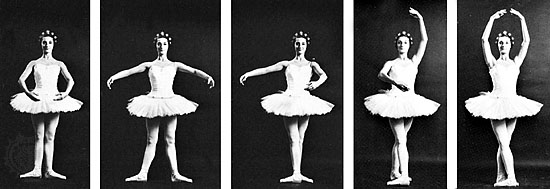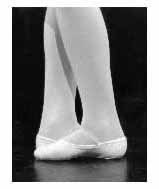
These are the five basic positions. Although some are used more than others, they are all very important. It's very important for a dancer to know these positions, because most main jumps, leaps, turns, and other steps begin with these.
 This is a very basic position, and is used frequently. Stand strait in "6th" position. This is when your feet are together and your toes are pointing to the front of you. Then, in one quick motion, take your toes to the side as far as you can. Don't scoot your toes back more afterwards, this will damage your knees. As you advance in ballet, you will become more and more turned out in the legs. Your arms are as simple as the feet, low and curved gently.
This is a very basic position, and is used frequently. Stand strait in "6th" position. This is when your feet are together and your toes are pointing to the front of you. Then, in one quick motion, take your toes to the side as far as you can. Don't scoot your toes back more afterwards, this will damage your knees. As you advance in ballet, you will become more and more turned out in the legs. Your arms are as simple as the feet, low and curved gently. Second position is one of my favorite positions. This is the only position where heels do not come off of the ground in grand plie. Starting from first, point your foot to the side and lower your heel. Your heels should be about 12 inches apart from each other. Arms are held to the side in a light, slightly curved line, with palms facing inward.
Second position is one of my favorite positions. This is the only position where heels do not come off of the ground in grand plie. Starting from first, point your foot to the side and lower your heel. Your heels should be about 12 inches apart from each other. Arms are held to the side in a light, slightly curved line, with palms facing inward. Third position is one of my least favorite positions for the feet, but my favorite for the arms. Third position is similar to fifth position, with both feet together and toes out to the side. but intead of heel to toe, it is heel to arch. Your heel should fit righ inside the little "cave" your arch makes. Third position arms are one arm in first and one arm in second.
Third position is one of my least favorite positions for the feet, but my favorite for the arms. Third position is similar to fifth position, with both feet together and toes out to the side. but intead of heel to toe, it is heel to arch. Your heel should fit righ inside the little "cave" your arch makes. Third position arms are one arm in first and one arm in second. I hate fourth position, but luckily we mostly use it in pirouettes and such. Fourth position is excactly like fifth position, but the feet are 12 inches apart instead of together. Stand in fifth position, and point your foot to the front and lower your heel. For fourth position arms, hold one in first, and one in fifth.
I hate fourth position, but luckily we mostly use it in pirouettes and such. Fourth position is excactly like fifth position, but the feet are 12 inches apart instead of together. Stand in fifth position, and point your foot to the front and lower your heel. For fourth position arms, hold one in first, and one in fifth.  Fifth position is the most commonly used position of them all. Stand in first position and slide your foot, heel first, across the other until you stand heel to toe, toe to heel. Fifth position arms are helds simply up in the air. In Fifth position arms, hold your arms so that they are in line with your cheeks, not your ears. When you line them with your ears, your shoulders go up.
Fifth position is the most commonly used position of them all. Stand in first position and slide your foot, heel first, across the other until you stand heel to toe, toe to heel. Fifth position arms are helds simply up in the air. In Fifth position arms, hold your arms so that they are in line with your cheeks, not your ears. When you line them with your ears, your shoulders go up.










No comments:
Post a Comment